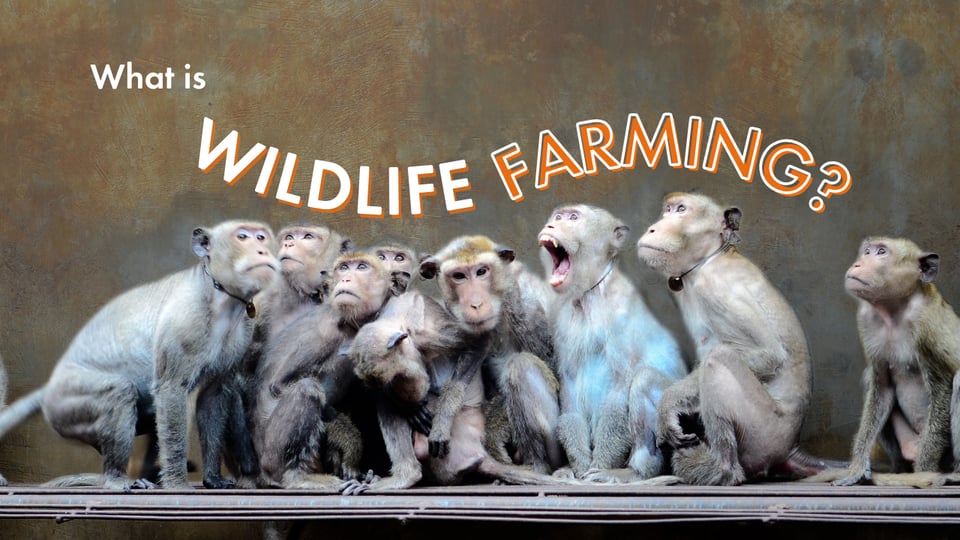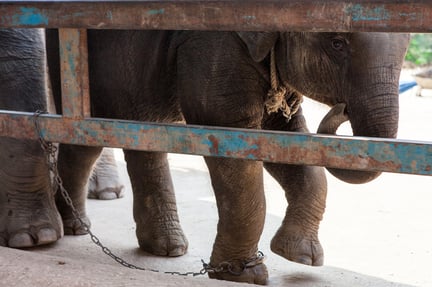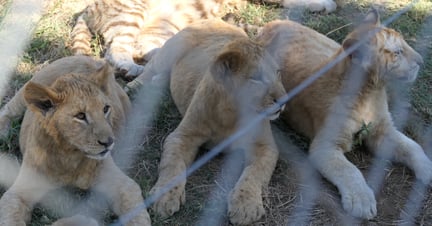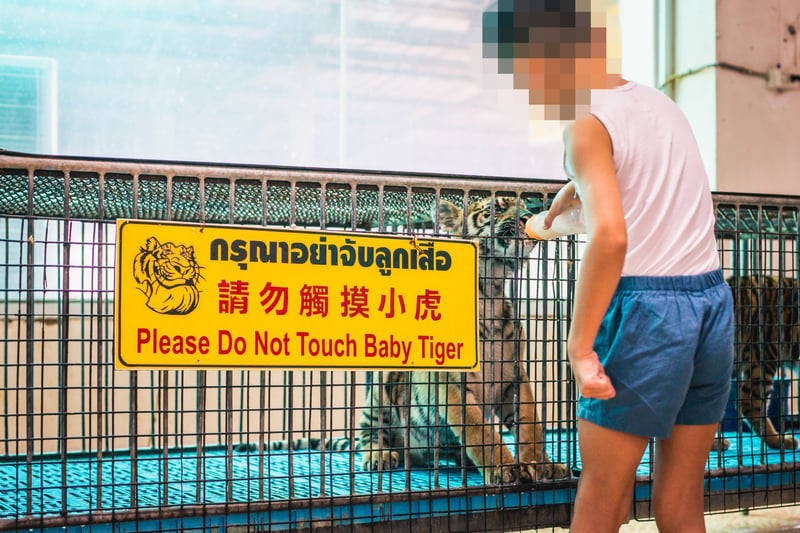
Wildlife farming is often touted as benefitting wildlife conservation but is this true? We explore the conservation case against wildlife farming.
Wildlife farming has often been defended as benefiting wildlife conservation efforts. By breeding the animals they want to sell, wildlife traders can supply their industry, avoid the inconsistent results of hunting, and skirt certain trade laws. Some people argue it also has a positive effect on the wild populations of targeted species since there is less demand for wild-caught animals.
However, these benefits are uncertain. To debunk these claims, this article examines the impact of wildlife farming on conservation. First, though, let’s discuss the meaning of conservation and why wildlife conservation is important.
What is conservation?
At its core, conservation’s meaning comes back to the careful and thoughtful management of the natural world to ensure the preservation of its biodiversity. The goal of wildlife conservation is to promote responsible and sustainable use of the planet’s natural resources to safeguard them for future generations. This includes the study of the planet and biodiversity loss, landscape and wildlife management, and educational and awareness programs.
Why is conservation important?
Conservation is important for a number of reasons, including preventing biodiversity loss, mitigating climate change, preserving historical and cultural heritage, and encouraging the responsible use of natural resources. Let’s explore these in more detail.
Preventing biodiversity loss:
Our planet is a finely-tuned ecosystem with everything in balance. When that balance is disrupted — as in the case of human-driven biodiversity loss — it puts all life at risk. Wildlife conservation seeks to prevent this.
Mitigating climate change:
Our plants and animals play an important role in preventing climate change through their natural behaviours and functions in their ecosystems. By protecting these species through conservation, wildlife and plants can continue to play these vital roles.
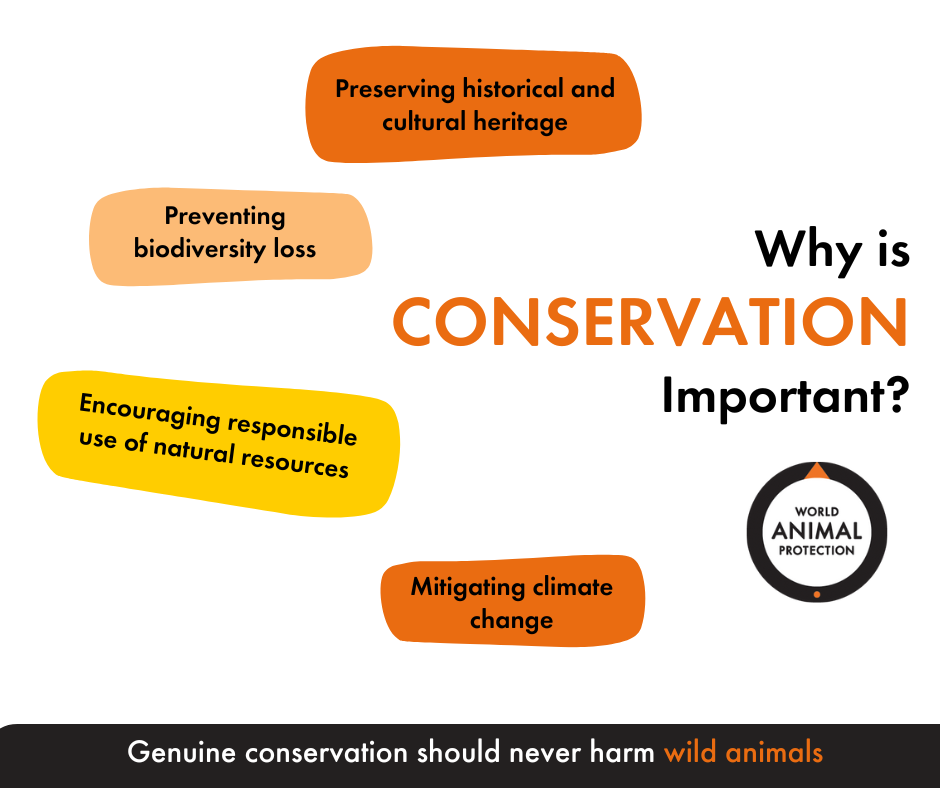
Preserving historical and cultural heritage:
Many communities live closely alongside nature and their local environments play an important role in their historical and cultural heritages. We can offset the loss and damage to these environments through conservation, meaning that the heritage of these communities remains protected long into the future.
Encouraging responsible use of natural resources:
Our planet is a finite resource. Conservation is important for encouraging a more sustainable approach to using our planet’s gifts, ensuring they are still present to support future generations.
Now we know why conservation is important, let’s look at why wildlife farming does not fit into any true conservation for wildlife initiatives.
Why wildlife farming is the problem, not the solution
One of the greatest dangers of the wildlife trade is that if demand increases, hunters and poachers will work to meet that demand, even if it means hunting a species to near or complete extinction. Those who support wildlife farming claim to see it as a solution to this conservation problem. By farming captive populations, they can meet demand while allegedly protecting wild populations.
However, there is little evidence to support this claim. Our Bred For Profit report presents multiple arguements for how farming can instead hamper conservation, wildlife, and ecosystems, showing some examples where wild populations are negatively affected by wildlife farming. In some extreme cases, wild populations have continued to dwindle, eventually becoming smaller than the captive populations.
Even if wildlife farming really did reduce the pressure on wild animals and aid conservation efforts, there is also a moral problem to consider. Is it acceptable to condemn captive populations to a life of work, stress, unsuitable habitats, malnutrition, disease, and injuries to prevent the overhunting of wild populations?
Needless to say, we don’t think it’s acceptable at all. We believe in the true conservation of wildlife and work to protect all animals from suffering, not to sacrifice some for the sake of others.
The impact of wildlife farming on conservation
The wildlife trade is one of the most significant drivers of extinction risk across the world, and wildlife farming helps keep trade thriving by sustaining and promoting demand for wildlife products. Farming separate captive populations of wild animals does not always reduce the threat of hunting in wild populations or have positive effects on wildlife conservation.
Instead, the lack of regulation in wildlife farming makes it possible for farms to act as laundering sites for illegally caught wild animals. In other cases, wild-caught animals are used to supplement numbers in wildlife farms when they can't meet consumer demand or struggle to successfully breed wildlife in captivity.
Some conservationists believe that wildlife farming could spark competition in the wildlife trade, as better results from farming could encourage people to change tactics and leave wild populations alone. Not enough analysis has been done to support this claim though, and those who care about protecting all animals from suffering don’t find the argument very convincing.
Captive populations can also have direct negative effects on wild populations. When farmed and wild animals can’t be distinguished, it can hamper monitoring and conservation efforts. Captive animals can also escape, spreading disease and altering the gene pool in wild populations.
@worldanimalprotection Wildlife Heritage Areas is a new programme designed to celebrate wildlife, the environment and local communities 🧡 #wildlife #responsibletravel #wildlifetourism ♬ original sound - World Animal Protection 🌎
Wildlife farming vs. genuine conservation
Although situations are often complex, there is a surefire way to determine what is conservation and what is not. Genuine conservation of wild species should never harm wild animals. Since the primary goal of wildlife farming is to breed
animals for profit, it could never be counted as wildlife conservation — regardless of any positive side effects it might produce. Animals on wildlife farms only exist to be sold into industries such as the tourism or illegal pet trades, or killed and used for food, fashion, or medicine.
How to conserve wildlife
True conservation for wildlife should strive to reduce the demand for animal products and push for wildlife-friendly alternatives, while helping to find replacement streams of income for workers. These initiatives should also ban certain products if they’re close to causing irreparable damage and there’s no time for a slow transition.
Wildlife conservation examples
The way different countries dealt with decreasing sea turtle numbers is a good example of wildlife conservation vs farming. In the Cayman Islands, unsustainable demand for sea turtle meat resulted in the opening of a turtle farm. The conditions were poor and the costs were high, costing taxpayers 44 million Caymanian dollars in just four years.
Réunion Island, however, wanted to avoid these drawbacks and instead turned one of its ranches into a research centre. They educated locals, engaged stakeholders and ensured their was time to refuse tensions between pro and anti-farming parties. They also used a public engagement strategy to refocus the cultural relevance of green turtles on to wild populations, rather than captive bred.
By educating the locals and sticking to regulations, engaging stakeholders and providing time to refuse tensions between pro and anti-farming parties they were able to restore numbers without wildlife farming.
World Animal Protection’s conservation for wildlife initiatives
World Animal Protection has partnered with the World Cetacean Alliance to develop the conservation for wildlife initiative “Wildlife Heritage Areas” to provide responsible locations for wildlife tourism across the globe. Too often, wildlife tourism is an exploitative practice that reduces animals to nothing more than tools for human entertainment.
Our Wildlife Heritage Areas engage local communities to protect, respect, and reconnect with their local ecosystem and encourage environments where humans and animals can coexist peacefully. With this initiative, we are setting a new global benchmark for wildlife tourism, while protecting our planet’s biodiversity and helping to reduce animal suffering.
Truly care about conservation? Dive into our latest wildlife campaigns below and join the movement to protect animals worldwide.
